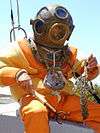Barodontalgia
| Barodontalgia | |
|---|---|
 | |
| Classification and external resources | |
| ICD-10 | W94 |
| ICD-9-CM | 993.2 |
Barodontalgia, commonly known as tooth squeeze and previously known as aerodontalgia, is a pain in tooth caused by a change in atmospheric pressure. The pain usually ceases at ground level.[1][2][3] The most common victims are SCUBA divers because in deep dives pressures can increase by several atmospheres,[4] and military pilots because of rapid changes.[5][6][7][8] In pilots, barodontalgia may be severe enough to cause premature cessation of flights.[9]
Most of the available data regarding barodontalgia is derived from high-altitude chamber simulations rather than actual flights. Barodontalgia prevalence was between 0.7% and 2% in the 1940s, and 0.3% in the 1960s.[7]
Similarly, cases of barodontalgia were reported in 0.3% of high altitude-chamber simulations in the Luftwaffe.[10]
The rate of barodontalgia was about 1 case per 100 flight-years in the Israeli Air Force.[11] During World War II, about one-tenth of American aircrews had one or more episodes of barodontalgia.[9] In a recent study, 8.2% of 331 Israeli Air Force aircrews, reported at least one episode of barodontalgia.[11]
Barodontalgia is a symptom of dental disease, for example inflammatory cyst in the mandible.[12] Indeed, most of the common oral pathologies have been reported as possible sources of barodontalgia: dental caries, defective tooth restoration, pulpitis, pulp necrosis, apical periodontitis, periodontal pockets, impacted teeth, and mucous retention cysts. One exception is barodontalgia manifested as referred pain from barosinusitis or barotitis-media. The latter two conditions are generated from pressure changes rather than pressure-related flare-up of pre-existing conditions.[13] A meta-analysis of studies conducted between 2001 and 2010[14] revealed a rate of 5 episodes/1,000 flight-years. Maxillary and mandibular dentitions were affected equally in flight, but in diving, maxillary dentition was affected more than the mandibular dentition, which can indicate a greater role for maxillary sinus pathology in diving barodontalgia.[14] Surprisingly, despite cabin pressurization, the current in-flight barodontalgia incidence is similar to the incidence in the first half of the 20th century. Also, despite the greater fluctuation in divers' pressures, the weighted incidence of barodontalgia among aircrews is similar to the weighted incidence among divers. Furthermore, contrary to common belief, and in contrast to diving conditions, the role of facial barotrauma in the etiology of in-flight barodontalgia is only minor (about one-tenth of cases).[14]
Classification
The Fédération dentaire internationale describes 4 classes of barodontalgia.[1] The classes are based on signs and symptoms. They also provide specific and valuable recommendations for therapeutic intervention.[1]
See also
References
- 1 2 3 Robichaud, R; McNally, ME (January 2005). "Barodontalgia as a differential diagnosis: symptoms and findings". J Can Dent Assoc. 71 (1): 39–42. PMID 15649340. Retrieved 2008-07-19.
- ↑ Rauch, JW (1985). "Barodontalgia--dental pain related to ambient pressure change". Gen Dent. 33 (4): 313–5. PMID 2863194.
- ↑ Weiner, R (2002). "Barodontalgia: caught between the clouds and the waves". J Mass Dent Soc. 51 (3): 46–9. PMID 12380041.
- ↑ Zadik, Yehuda; Drucker Scott (September 2011). "Diving dentistry: a review of the dental implications of scuba diving". Aust Dent J. 56 (3): 265–71. doi:10.1111/j.1834-7819.2011.01340.x. PMID 21884141. Retrieved 15 December 2011.
- ↑ Brubakk, Alf O; Neuman, Tom S (2003). Bennett and Elliott's physiology and medicine of diving (5th Rev ed.). United States: Saunders Ltd. p. 800. ISBN 0-7020-2571-2.
- ↑ Lyons, KM; Rodda, JC; Hood, JA (March 1999). "Barodontalgia: a review, and the influence of simulated diving on microleakage and on the retention of full cast crowns". Mil Med. 164 (3): 221–7. PMID 10091498.
- 1 2 Dehart, RL; Davis, JR (2002). Fundamentals Of Aerospace Medicine: Translating Research Into Clinical Applications (3rd Rev ed.). United States: Lippincott Williams And Wilkins. p. 720. ISBN 978-0-7817-2898-0.
- ↑ Gonzalez Santiago, Maria del Mar; Martinez-Sahuquillo Marquez, Angel; Bullón-Fernández, Pedro (2004). "Incidence of barodontalgias and their relation to oral/ dental condition in personnel with responsibility in military flight" (PDF). Med Oral. 9 (2): 98–105, 92–8. PMID 14990875. Retrieved 2008-07-19.
- 1 2 Zadik, Yehuda (January 2009). "Aviation dentistry: current concepts and practice" (PDF). British Dental Journal. 206 (1): 11–6. doi:10.1038/sj.bdj.2008.1121. PMID 19132029. Retrieved 2009-01-26.
- ↑ Goethe, WH; Bäter, H; Laban, C (October 1989). "Barodontalgia and barotrauma in the human teeth: findings in navy divers, frogmen, and submariners of the Federal Republic of Germany". Mil Med. 154 (10): 491–5. PMID 2515472.
- 1 2 Zadik, Yehuda; Chapnik, L; Goldstein, L (June 2007). "In-flight barodontalgia: analysis of 29 cases in military aircrew". Aviat Space Environ Med. 78 (6): 593–6. PMID 17571660. Retrieved 2009-01-27.
- ↑ Zadik, Yehuda (August 2006). "Barodontalgia due to odontogenic inflammation in the jawbone". Aviat Space Environ Med. 77 (8): 864–6. PMID 16909883. Retrieved 2009-01-27.
- ↑ Zadik, Yehuda (April 2009). "Barodontalgia". J Endod. 35 (4): 481–5. doi:10.1016/j.joen.2008.12.004. PMID 19345791. Retrieved 2009-06-01.
- 1 2 3 Zadik, Yehuda (April 2010). "Barodontalgia: what have we learned in the past decade?". Oral Surg Oral Med Oral Pathol Oral Radiol Endod. 109 (4): e65–9. doi:10.1016/j.tripleo.2009.12.001. PMID 20303049.
